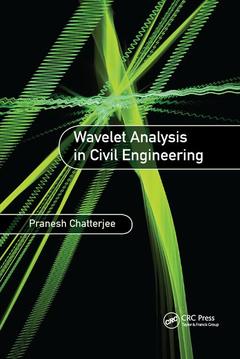Description
Wavelet Analysis in Civil Engineering
Author: Chatterjee Pranesh
Language: English
Subjects for Wavelet Analysis in Civil Engineering:
Keywords
Wavelet Coefficients; Wavelet Domain; Fourier Transform; Wavelet Transform; tank-liquid-foundation system; Wavelet Analytic Technique; NOR data; SDOF System; General equations of Motion; Hydrodynamic Pressure; Duffing oscillator; Continuous Wavelet Transform; Duffing equation; Damping Ratio; Perturbation method; Wavelet Basis Function; Runge-Kutta fourth-order method; Base Shear; Ground Motion; Tank Wall; MDOF system; Mother Wavelet; B Tf; Base Shear Coefficient; Time History; Time History Simulation; Ground Motion Characterization; Mexican Hat Wavelet; Wavelet Function; Shear Wave Velocity; Dwt; Morlet Wavelet; Rayleigh Damping Parameters; Response Spectrum
Publication date: 07-2017
· 15.6x23.4 cm · Paperback
Publication date: 02-2015
224 p. · 15.6x23.4 cm · Hardback
Description
/li>Contents
/li>Biography
/li>
Wavelets as a Powerful Signal Processing Tool
The principles of wavelets can be applied to a range of problems in civil engineering structures, such as earthquake-induced vibration analysis, bridge vibrations, and damage identification. This book is particularly useful for graduate students and researchers in vibration analysis, especially those dealing with random vibrations.
Wavelet Analysis in Civil Engineering Comprised of seven chapters, this text:
- Introduces the concept and utility of wavelet transform
- Describes the discretization of ground motions using wavelet coefficients
- Explains how to characterize nonstationary ground motions using statistical functionals of wavelet coefficients of seismic accelerations
- Develops the formulation of a linear single-degree-of-freedom system
- Shows stepwise development of the formulation of a structure idealized as a linear multi-degree-of-freedom system in terms of wavelet coefficients
- Defines wavelet domain formulation of a nonlinear single-degree-of-freedom system
- Introduces the concept of probability in wavelet-based theoretical formulation of a nonlinear two-degree-of-freedom system
- Covers a variety of case studies highlighting diverse applications
Wavelet Analysis in Civil Engineering
Introduction to Wavelets. Vibration Analysis of SDOF system in wavelet domain. Ground Motion Characterization and Validation of PSA spectrum. Fixed Based Tank Response Analysis. Seismic Soil-Tank-Fluid Interaction Analysis. Analysis of Bridge-Weigh-In-Motion NOR signals. Damage Identification Techniques. Nonlinear Soil-Structure Interaction Analysis.
Dr Pranesh Chatterjee has earned undergraduate and postgraduate degrees in civil engineering and subsequently adoctorate in engineering from Jadavpur University, India. Dr Chatterjee took up post-doctoral fellowship in structural mechanics at Katholieke Universiteit te Leuven in Belgium and then was selected as prestigious Pierse Newman Scholar at University College Dublin in Ireland. He is working as Manager of Plasticity and Tribology group of Tata Steel Europe in the Netherlands. He is active in research and publication of research works.

